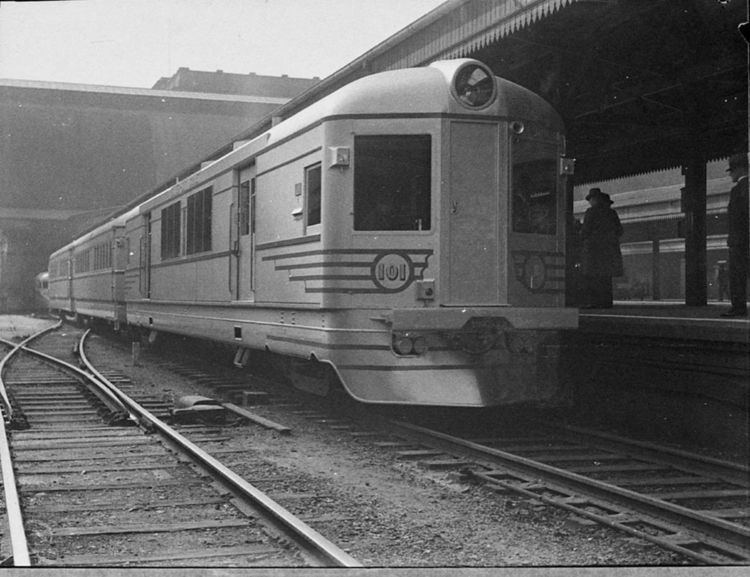Service type Passenger train First service 27 September 1937 | Status Ceased Last service 3 November 1989 | |
 | ||
The Silver City Comet was a train service that operated from September 1937 until November 1989 between Parkes and Broken Hill in western New South Wales. It was the first air-conditioned train in the British Empire.
Contents
Design
The original engines were built in Belfast by Harland & Wolff under licence from Burmeister & Wain known as the "Harlandic" type. An eight cylinder in line uniflow two-stroke engines with blower scavenging which developed 330 bhp (250 kW) at 1200 rpm. The transmission was a Voith torque converter design with two gear ratios, geared for 130 km/h (81 mph) and 115 km/h (71 mph). Two "National" 22 kW (30 hp) diesel generator sets producing DC power for train lighting and air conditioning.
In 1953 spare parts supply difficulties and engine age prompted the NSWGR to re-engine the fleet with four 6-110 GM diesel engines rated at 250 bhp (190 kW) at 1800 rpm coupled in pairs driving Allison torque converters to the inner axle of each bogie. These are coupled in pairs through a GM Model TCLA 965 torque converter to gear boxes connected to each of the bogies. A Standard Waygood GM 120 volt, 50 kW (67 hp), generator set for power requirements including train lighting, cooking and air conditioning. The power van was re-classed 'DP', tare weight was 63 long tons (64 t; 71 short tons).
Service
Broken Hill had two tramways which were established by the early 1900s. One was closed in 1926 due to being unprofitable while the other was converted to standard gauge rail in 1919 and eventually connected to Sydney via the Broken Hill line in 1927.
When the rolling stock was ordered, it was planned that they would be utilised on both the Parkes to Broken Hill and Dubbo to Bourke services. In September 1937 the Silver City Comet commenced operating three times a week between Parkes and Broken Hill connecting with the Western Mail from Sydney. This was increased to daily from May 1938 before reverting to thrice weekly in October 1939. This released some stock for transfer to Sydney to operate Federal City Express services to Canberra from October 1939 until November 1945. In April 1940 the remaining stock was also transferred to Sydney to operate Newcastle Flyer services for a few months.
From January 1957, Silver City Comet stock operated a three times per week service from Parkes to Orange and Dubbo. Following the introduction of the Central West XPT service to Dubbo, in April 1982 this was cut back to Orange.
Rolling stock
The New South Wales Government Railways placed orders for five diesel power vans with Eveleigh Carriage Workshops and 12 trailer cars with Ritchie Brothers, Auburn in the mid-1930s. The double ended power cars were each fitted with two Harland & Wolff Hardlandic diesel engines. One was destroyed by fire at Ivanhoe in January 1950 with the remaining four repowered with General Motors 6-110 engines between 1952 and 1957. Another was withdrawn after being struck at a level crossing at Forbes in August 1982. The carriages were the first in Australia to feature air-conditioning.
Originally painted silver with blue lining, in the 1950s they were repainted in the standard tuscan and russet livery. By the 1970s they had returned to their original livery. In the 1980s they were repainted into the State Rail Authority's candy colours before once again being returned to their original livery in time for their 50th anniversary in 1987.
In its twilight years the Silver City Comet became a popular train for enthusiast tours including operating up the North Coast line to Brisbane in April 1986 and the Main Northern line to Tenterfield in October 1989.
In September 1987, to celebrate the 50th anniversary of their entry into service, a set operated tours from Sydney to Canberra and Kiama.
Demise & Preservation
On 3 November 1989 the final Silver City Comet ran with road transport taking over the service.
Following their withdrawal in November 1989 the rolling stock was disposed of. The State Rail Authority donated a power van and four carriages to the City of Broken Hill that was placed on display at the Sulphide Street Railway Museum, and a carriage to the City of Parkes. The Dorrigo Steam Railway & Museum and New South Wales Rail Transport Museum each purchased a power van and four and three carriages respectively. These latter two both moved to the Rail Motor Society, Paterson in April 1990. Dorrigo's stock was moved to Kooragang Island in May 1994 while the Rail Transport Museum's stock moved to Thirlmere in April 1999.
